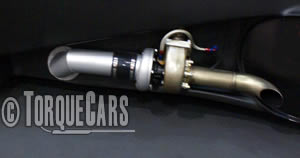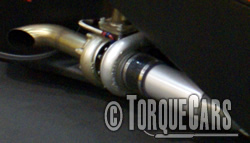Remote turbo charger kits
"Remote turbo - local power"

There is a growing trend in the car tuning community of adding a remote turbo to a car.
We take a look at this modification and look at the pros and cons of remote turbos.
A conventional turbo is fitted pretty much on the engine in line with the exhaust header manifold.
A remote turbo is fitted much further down the exhaust than a convention turbo which is typically located in the engine bay.
Remote turbos are usually installed at the rear of the vehicle where the rear silencer would join the exhaust, or instead of the rear silencer, although we have seen them mounted underneath the car just behind the cat and at the side of the car.
A remote turbo still works in a similar way to a conventional turbo, using the exhaust gases to drive a turbine connected to an intake turbine that compresses the intake air.
The compressed intake air is then channelled back to the front of the car and into the engine. Despite the length of the run the delivery is to all practical purposes instantaneous.
You will need to cut the exhaust and allow the turbo to be fitted into the exhaust gas stream. You will also need piping to take the compressed air charge back to the intake. Metal is usually best as this will be more sturdy and resist stones and other items, a split would mean a leak and a loss of pressure.
The turbo will need a good and steady supply of oil. Taking a braided hose from the sump and backing this up with an electric pump will help to lubricate and cool the turbo. It would be possible to run the oil through an oil cooler if temperature becomes a problem.
Next you will need to adjust the fuelling. More air coming into the engine will require more fuel otherwise you will be running lean.
Safety systems will need to be added. If the turbo runs too hot or the oil line cuts out it would be detrimental to the turbo to keep the engine running.
Depending on the boost provided and your vehicles mapping, you will also need to factor in some further modifications to control the exhaust flow through the turbo in the form of a waste gate control and a diverter valve to cut in when you come off throttle to avoid overboost.
If you are running higher boost levels you should either reduce the engines compression ratio or introduce other measures against detonation like water injection and using higher octane fuel.
Thankfully the remote turbo is simple in it's setup and tolerates a wide range of varying conditions compared to a conventional turbo.

What are the pros of a remote turbo?
They are easier to fit typically requiring a cut in a straight section of exhaust. They run at lower temperatures than standard turbos so require less lubrication and cooling. Due to the length of the run back to the engine intake there is little need for an intercooler.
Their lower boost characteristics avoids many problems with detonation associated with adding a turbo to a conventional engine.
So what are the drawbacks of remote turbos?
They do not provide as much power or potential power as a traditionally mounted turbo. It can reduce your ground clearance depending on where it is located. You can get round this by mounting it level and near to an axle will provide adequate clearance.
Due to its location a remote turbo is not very well shielded from stones and impacts. Adding a guard is generally a good idea and a sturdy mesh would still allow plenty of airflow around the turbo housing.
You can source a cheap turbo unit from a breakers yard, it then is just a matter of fabricating the piping and exhaust flow yourself and setting up the timing. (TorqueCars would not recommend using a diesel turbo unit on a petrol engine as these are setup for much lower exhaust flow rates and lower temperatures.) Remote turbos work really well on large block V6 and V8 engines but we have seen applications and kits that will work on lesser cars.
We would recommend starting off with a very low boost setting and running the car on a rolling road with diagnostic equipment to monitor the air to fuel ratio and measure the risk of detonation. Gradually tweak the boost and mapping until you reach the optimum setting for the vehicle and then for safety and reliability back it off a little.
Join us in our friendly forum to discuss remote turbos, supercharger kits and any other imaginable application for forced induction.
If you liked this page please share it with your friends, drop a link to it in your favourite forum or use the bookmarking options to save it to your social media profile.
Check out TorqueCars new YouTube channel, and see their awesome new content...
Feedback
Please use our forums if you wish to ask a tuning question, and please note we do not sell parts or services, we are just an online magazine.
Help us improve, leave a suggestion or tip
